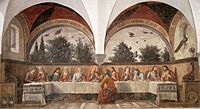Karamu ya mwisho


Karamu ya mwisho inamaanisha mlo wa mwisho wa Yesu Kristo hapa duniani, ambao aliula pamoja na mitume wake kabla hajakamatwa na hatimaye kusulubiwa.[1]
Katika Injili, hasa ile ya Luka, Yesu alishiriki mara nyingi karamu alizoandaliwa au alipoalikwa, kama vile ile ya arusi ya Kana. Ingawa jambo hilo lilisababisha aitwe "mlafi na mlevi", kwake ilikuwa nafasi ya kuzidi kujitambulisha kwa matendo na maneno na ya kutoa mafundisho yake.
Habari za karamu ya mwisho zinasimuliwa kirefu zaidi, hasa kwa sababu ndiyo wakati wa Yesu kuweka ukumbusho wake wa kudumu katika sakramenti ya mwili na damu yake.[2]
Wakristo wanafanya ukumbusho huo mara nyingi, lakini hasa Alhamisi Kuu.[3]
Barua ya kwanza kwa Wakorintho ndiyo ushahidi wa zamani zaidi kuhusu ibada hiyo. Baada yake Injili Ndugu pia ziliripoti matendo na maneno ya Yesu juu ya mkate na divai.
Injili ya Yohane haisimulii ekaristi ilivyowekwa, ila katika sura ya 6 inaripoti maneno mazito ya Yesu kuhusu mkate wa uzima, halafu katika karamu ya mwisho, pamoja na mengine, inaeleza Yesu alivyowaosha miguu Mitume na kuwaachia amri mpya ya kupendana kama yeye alivyowapenda, ambayo ndiyo lengo la ekaristi.[4][5][6]
Picha
[hariri | hariri chanzo]- Michoro ya karamu ya mwisho
-
Domenico Ghirlandaio, 1480, alimchora Yuda peke yake
-
Ekaristi ya kwanza, kadiri ya Juan de Juanes, karne ya 16
-
Mchoro wa Jerg Ratgeb
-
Mchoro wa Jaume Huguet
-
Mchoro wa Tiepolo
Tanbihi
[hariri | hariri chanzo]- ↑ "Last Supper. The final meal of Christ with His Apostles on the night before the Crucifixion.", Cross, F. L., & Livingstone, E. A. (2005). The Oxford Dictionary of the Christian Church (3rd ed. rev.) (958). Oxford; New York: Oxford University Press.
- ↑ Walter Hazen (1 Septemba 2002). Inside Christianity. Lorenz Educational Press. Iliwekwa mnamo 3 Aprili 2012.
The Anglican Church in England uses the term Holy Communion. In the Roman Catholic Church, both terms are used. Most Protestant churches refer to the sacrament simply as communion or The Lord's Supper. Communion reenacts the Last Supper that Jesus ate with His disciples before He was arrested and crucified.
{{cite book}}: CS1 maint: date auto-translated (link) - ↑ Gwyneth Windsor, John Hughes (21 Novemba 1990). Worship and Festivals. Heinemann. Iliwekwa mnamo 11 Aprili 2009.
On the Thursday, which is known as Maundy Thursday, Christians remember the Last Supper which Jesus had with His disciples. It was the Jewish Feast of the Passover, and the meal which they had together was the traditional Seder feast, eaten that evening by the Jews everywhere.
{{cite book}}: CS1 maint: date auto-translated (link) - ↑ The Gospel according to John by Colin G. Kruse 2004 ISBN 0-8028-2771-3 page 103
- ↑ "The custom of placing the eucharist at the heart of the worship and fellowship of the Church may have been inspired not only by the disciples’ memory of the Last Supper with Jesus but also by the memory of their fellowship meals with Him during both His days on earth and the forty days of His risen appearances.", Bromiley, G. W. (1988; 2002). Vol. 3: The International Standard Bible Encyclopedia, Revised (164). Wm. B. Eerdmans.
- ↑ The Oxford History of Christian Worship. Oxford University Press, USA. 2005. ISBN 0-19-513886-4
Marejeo
[hariri | hariri chanzo]- Brown, Raymond E. An Introduction to the New Testament Doubleday 1997 ISBN 0-385-24767-2
- Brown, Raymond E. et al. The New Jerome Biblical Commentary Prentice Hall 1990 ISBN 0-13-614934-0
- Bultmann, Rudolf The Gospel of John Blackwell 1971
- Kilgallen, John J. A Brief Commentary on the Gospel of Mark Paulist Press 1989 ISBN 0-8091-3059-9
- Linders, Barnabas The Gospel of John Marshall Morgan and Scott 1972
Viungo vya nje
[hariri | hariri chanzo]- "Last Supper" on Encyclopædia Britannica Online.
 "The Last Supper". Catholic Encyclopedia. New York: Robert Appleton Company. 1913.
"The Last Supper". Catholic Encyclopedia. New York: Robert Appleton Company. 1913.
| Makala hii kuhusu mambo ya Biblia bado ni mbegu. Je, unajua kitu kuhusu Karamu ya mwisho kama historia yake au athari wake? Labda unaona habari katika Wikipedia ya Kiingereza au lugha nyingine zinazofaa kutafsiriwa? Basi unaweza kuisaidia Wikipedia kwa kuihariri na kuongeza habari. |








